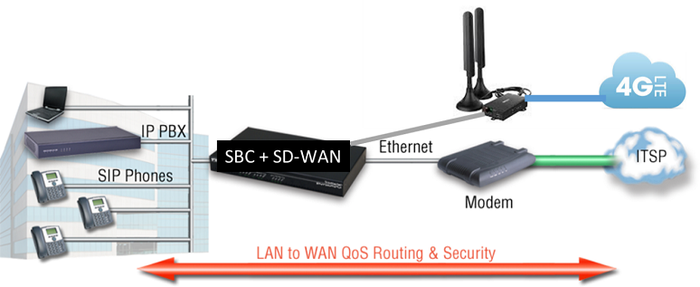SBC Plus SD-WAN Equals Survivable Branch UCSBC Plus SD-WAN Equals Survivable Branch UC
Why integrating SBCs with SD-WAN makes sense when voice is mission-critical to the branch office.
April 4, 2019

Oracle purchased Talari Networks late last year, and just a couple of weeks ago at Enterprise Connect 2019 Ribbon Communications and 128 Technology announced a partnership. So why are the top session border controller (SBC) companies forging integrations with software-defined WAN (SD-WAN) offerings? The answer lies in hyper-competitive markets like retail, where high-quality, reliable voice service is imperative.
Customers call retail outlets all the time to see if the latest hot toy is in stock, check pricing, get status on prescription availability, and verify store hours. If the retailer doesn’t answer such calls in a timely manner, odds are high that customers will go to a competitor. An even worse experience than an unanswered call is a disconnection halfway through a conversation.
Traditionally, a retail store would have a local PBX or auto-attendant and an analog POTS line --and expensive model that prohibits agility and lacks integration. As retailers work on their stores of the future, they want to centralize telephony into the cloud (private or public) to reduce costs, integrate voice with other communication channels, and be more agile. This strategy includes moving some users to softphones, while still providing a hard phone to power users who support multiple calls concurrently. But this sort of migration takes time, and during the transition legacy equipment and circuits might remain within a store.

The store SBC provides:
Analog interfaces -- if required at the store for things like paging systems, walkie-talkies, old fax machines and phones
Voice quality -- with the ability to monitor voice quality and troubleshoot any issues that may arise
Centralized signaling -- while keeping the media distributed
Voice security -- SIP signaling and media security
Interoperability -- allowing different vendor solutions to interoperate
The store SD-WAN provides:
Network quality -- when congestion occurs, the ability to reroute to a better network path, i.e., Internet and LTE network links instead of MPLS, in under one second
Network security -- network segmentation from the store LAN, across the WAN, and into the cloud, encrypting the traffic if required
Internet offload -- instead of bouncing through a data center, being able to route directly to UC or other collaboration platforms such as Cisco Webex Teams or Microsoft Teams
Together, both can provide centralized orchestration and management to meet today’s and future requirements. Many retailers, for example, envision using one- or two-way video calling. As a case in point, last summer I worked on testing out video calling for an auto parts retailer. (Since I like to work on old cars, I’m always needing parts.) I was able to use video calling to show a parts dealer what was wrong with the car, as well as the part I needed. This was very helpful. We were even successful on bringing in third-party video from YouTube or an expert from another store who had experience in the make and model of car I was working on.
Faster + better + cheaper + more secure is the goal of all great solutions. In this day and age, why make trade-offs when you can have it all?
About the Author
You May Also Like





